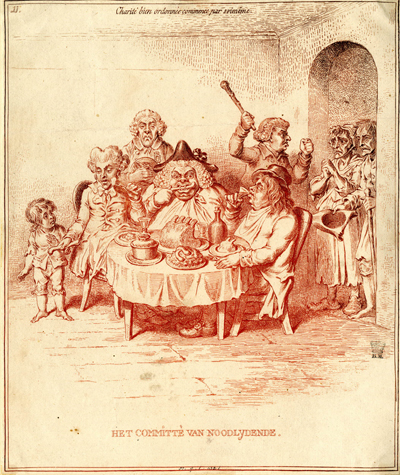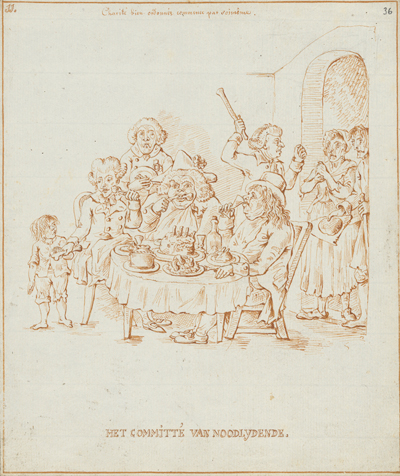Het Committé van Noodlydende
This is the eleventh plate of a twenty plate series, Hollandia Regenerata, etched by Gillray based on drawings by the Swiss soldier, painter, and caricaturist, David Hess. For more about David Hess, and the political and artistic context of the series satirizing the newly-created and French-supported Batavian Republic, see my Introduction.
The title of the print can be translated as "The Committee of the Distressed." It shows the decidedly un-distressed committee members at dinner stuffing themselves with food and drink while a servant waits upon them in the background and a brutish doorman with a bludgeon drives away the truly distressed and emaciated couple begging in the doorway. The French influence upon the committee is suggested by the dandified-looking man with ear rings daintily holding a fork while offering nothing more substantial than a bare bone to the shoeless boy in tattered clothes next to him. In the middle a grossly fat Dutchman with a standing rib roast before him attacks the remainder of one rib. And on the right another chubby committee member sips his wine. Above their heads is an subtitle: "Charité bien ordonnée commence par soimême" (Charity, well-ordered, begins with oneself) which the committee members are obviousy following all too literally.

Het
Committé van Noodlydende
[1796?]
© Trustees of the British Museum
In 1795, Holland was still suffering from the aftermath of the War of the First Coalition. As allied troops retreated before the French attack, they showed little or no concern for the land and people they were abandoning. As Simon Schama notes in his book, Patriots and Liberators
The evacuation of Nijmegen by the British had been accompanied by a carnival of pillage, violence, and rapine, on a scale and with a wanton abandon which more than any Patriot propaganda persuaded the Dutch to defend themselves against their defenders.(184)
In Overijssel, the steady bombardment in the war's final stages
. . .destroyed many of the first defense dykes. Much arable land had been flooded and the vicious frosts of late December and early January had destroyed the potasto crop in large areas of the province. What had been left of grain and vegetables had been seized, first by the British, then by French troops, so that by April [1795] the countryside was denuded of both livestock and crops. In Twente, men were reported to be eating bark and millet. Almost a third of the province's population succembed to famine conditions. As if this were not enough, the requisitions levied by the French army completed the misery. (224)
As with all the plates in the series, the corresponding page to the image contains one or more appropriately ironic Biblical quotations in Dutch and English and a satiric "Explanation" in French. The Biblical quotation makes it clear that the lip service of repubican ideals does not put food in hungry bellies.:
James, ii. 15, 16. "If a brother or sister be naked and be destitute of daily food; and one of you say unto them; Depart in peace, be ye warmed, and be ye filled; notwithstanding ye give them not those things, which are needful to the body; what doth it profit?"
Hess's ironic "Explanation" has a remarkably familiar sound even today in countries where wealth and power are concentrated in the hands of a few.
Here is the French text of the "Explanation."
Charité bien ordonnée commence par soi-même. Il ne faut pas encourager la paresse et l'oisiveté, en faisant l'aumone à tous les pauvres. Qu'on chasse ces gueux qui viennent assiégér la porte du Committé! Ces bons citoyens ne dineroient ils pas en repos? Apres avoir donné du ton à leur estomach ils verront ce qui reste à faire pour les malheureux!
And here is my free English translation.
Charity begins at home. We must not encourage laziness and idleness by giving alms to all the poor. Let those beggars who besiege the door of the Committee be driven out! Should not these good citizens be able to dine in peace? After filling their stomachs, they will see what remains to be done for the unfortunate!

Het
Committé van Noodlydende
[1796?]
© Zentralbibliothek Zürich
Like most of the plates of Hollandia Regenerata, Gillray follows the Hess's drawing closely. The basic disposition of the figures and meaning of the print both derive from Hess, but Gillray has sharpened every line and, with a wonderful use of shading, given a depth and solidity to the background, foreground, and figures (especially their clothes) that is missing in the original Hess drawing. Small differences, however, can be observed. Gillray has made the Frenchified man more dandyish, especially with the way he holds his fork. He has made the small boy sadder and less sullen. And he has given the faces of the beggars more character and definition.
Sources and Reading
- Commentary from the British Museum on Het Committé van Noodlydende.
- "Batavian Republic," Wikipedia
- "Flanders campaign," Wikipedia
- "David Hess (painter)," Wikipedia
- "David Hess," SIKART Dictionary
- David Hess, Hollandia Regenerata (1797), Nawoord by Joost Rosendahl, Uitgeverij Vantilt, 2007
- Simon Schama, Patriots and Liberators: Revolution in the Netherlands 1780 - 1813, London, 1992
Comments & Corrections
NOTE: Comments and/or corrections are always appreciated. To make that easier, I have included a form below that you can use. I promise never to share any of the info provided without your express permission.